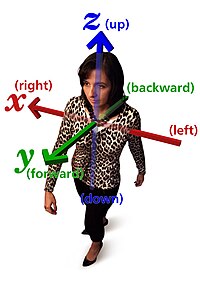Body relative direction

When we talk about body relative direction, we mean the direction of something in relation to our body. Imagine you are standing up, with your feet firmly planted on the ground. Your body is like a compass, and you can use it to figure out where things are in relation to you.
For example, if you hold out your hand to your right side, the direction that your hand is pointing is to your right. If you turn your head to the left, the direction that you are looking is to your left. If you hold something in front of you, the direction that it is facing is in front of you.
It's kind of like when you use your fingers to make a pretend gun and point it in different directions. You know that your fingers aren't really a gun, but you can use them to figure out which way you are pointing.
As you move around, the direction of things will change. If you turn to the left, the direction that things are in will shift to the right. If you tilt your head back, the direction of things will shift upwards.
By understanding body relative direction, we can navigate the world around us and find our way to where we need to go. It helps us to understand where things are in relation to our bodies, and how we need to move to get to them.
For example, if you hold out your hand to your right side, the direction that your hand is pointing is to your right. If you turn your head to the left, the direction that you are looking is to your left. If you hold something in front of you, the direction that it is facing is in front of you.
It's kind of like when you use your fingers to make a pretend gun and point it in different directions. You know that your fingers aren't really a gun, but you can use them to figure out which way you are pointing.
As you move around, the direction of things will change. If you turn to the left, the direction that things are in will shift to the right. If you tilt your head back, the direction of things will shift upwards.
By understanding body relative direction, we can navigate the world around us and find our way to where we need to go. It helps us to understand where things are in relation to our bodies, and how we need to move to get to them.
Related topics others have asked about:
